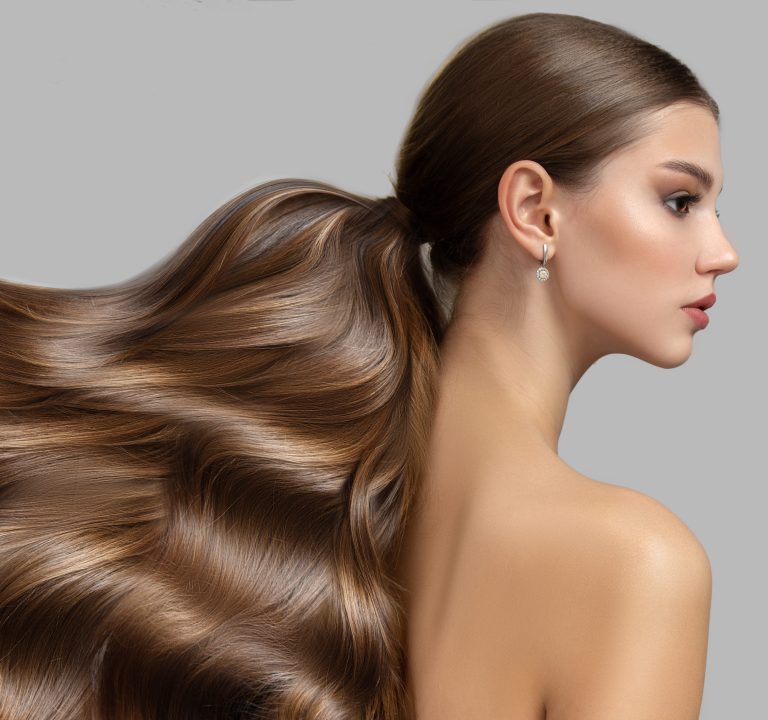KALILIGHT: anti-pollution & lightening with stabilized glutathione
Introduction

16 May 2023
In the past decade pollution has become a topic of relevant concern for cosmetics consumers; several studies have proven its harmful impact, as pollutants like particulate matter, nitrogen and sulfur oxides, ozone, and polyaromatic hydrocarbons damage skin by different mechanism resulting in skin dryness, loss of firmness, dark spots, uneven skin tone, fine lines and wrinkles, aggravation of acne, and inflammation.
Pollution has long been a consumer concern in Asia due to high level of pollution in cities like Shanghai and Beijing in China, New Delhi and Bangalore in India; although its level is not as high in Europe and North America, pollution is now making headlines in west and recently pollution level across continent of Africa has also increased significantly.
As a result, though the anti-pollution movement first began in Asia Pacific region, it is finally moving into western markets also and hundreds of commercially successful products can be seen in nearly every major market across the world.
Pollution related skin damage
Pollution negative impact can be observed at the skin surface, the stratum corneum, which is normally colonized with residual microorganisms. In the presence of pollutants, in fact, the skin microbiome changes for the benefit of pathogenic bacteria .
The impact of pollutants on human skin can be divided into short-term and long-term effects. Whether and when these effects occur depends of course on exposure time and dose. Some of the so far reported short-term effects are accumulation of toxins on the skin, irritation, (micro) inflammation, oxygen deficiency, clogging of pores, impairment of skin barrier, dryness / lack of moisture, excessive desquamation, pigment spots, altered metabolism as well as protein, lipid, and DNA oxidation. Not every effect is directly noticeable, but a persistent dryness can for instance lead to itchy and rough feeling skin.
Moreover, skin can look slightly pale/dull over time. It has also been shown that pollutants affect the metabolism of isolated human cells which in turn resulted in highly increased oxidative stress levels and consequently cell damage and reduced cell activity leading to cell death . As a long-term effect , a connection between a high exposure to air pollution and signs of premature skin ageing had been reported by several researchers. Particulate matter (PM) seems to be the reason for accelerated formation of wrinkles. One mechanism could be the activation of enzymes which initiate and increase the collagen degradation process. PM has also been linked to impurities and acne, allergies, age spots (hyperpigmentation), sensitivity, vitamin E deficiency, mutations and even skin cancer. Some facial occurrences linked to PM have also been reported like dark circles around the eye, sagging of eyebrow, increased fine lines, thinner lips and blemishes which could appear due to trapped toxins in pores.
The main problem, according to unanimous opinion, is the formation of oxygen radicals (ROS) and the oxidative stress in skin cells which is dramatically increased by PM. ROS were proven to deplete the content of antioxidants in the skin. This causes disturbance in the redox balance, causing stress to the cells. Some pollutants also tend to permeate through the stratum corneum into deeper skin layers. There, they act as a ligand for the Aryl hydrocarbon receptor (AhR), which takes part in mediating toxic effects of pollutants. The alterations of microflora, oxidative stress, and the activation of AhR cause the induction of an inflammatory cascade in the skin. The increased production of pro-inflammatory cytokines, such as interleukin 1β or interleukin 8, greatly impacts the biological function of the cells, resulting in skin lesions and deterioration of skin appearance, as well as the accumulation of eumelanin, leading to the formation of skin spots.
What can anti-pollution products really do to prevent or fight these problems? The main objectives of current products in the market are: detoxification, rebalance and protection. However, given the large number of different pollutants in the air or to which our skin could be exposed to in different areas, the choice of working ingredients for a functional anti-pollution formulation is not trivial. First of all, one needs to have an overview about the skin parameters that are reported to be altered by pollutants. It has been found in recent research that several so-called biomarkers were altered upon exposure to different pollutants. Some biomarkers are usually increased relatively quickly after pollution treatment like: pH, lactic acid content , sebum production and secretion, advanced glycation end products (AGE), malondialdehyde (MDA) and squalene monohydroperoxide (SQOOH) (marker for lipid peroxidation), protein oxidation, cellular oxidative stress levels (radicals), Interleukin-1a (IL), IL-6. IL-8 (inflammatory markers), tissue oxygenation, matrix metalloproteinases (1, 2, 3, 9, 12), cell survival & proliferation, DNA damage etc.
In contrast there are some downregulated biomarkers upon anti-pollution treatment: Vitamin E content, cholesterol content, skin lipid level (triglycerides, wax esters, free fatty acids. squalene, the ratio among themselves). All of these markers can be addressed to evaluate the efficacy of a product or formulation against distinct particle mater treatment.
Influence of pollution on skin microbiome
The skin is colonialized by various types of micro-organisms, which form the residual skin microbiome. Its composition varies slightly between individuals and body parts, it is dependent on age, diet, lifestyle, and environment.
It is known that the skin ecosystem is linked with the human immune system, supports the proper skin barrier function, and influences overall human health. Air pollutants have a negative impact on skin microflora (specific studies proved a decrease in residual skin microflora of about 50% in the presence of ozone) : these alterations can cause colonization of the stratum corneum with pathogenic strains of bacteria.
The relation between ambient air pollution and acne has also been confirmed. Pollution particles settle on the skin, blocking pores and therefore creating an anaerobic environment—ideal conditions for growth of Propionibacterium acnes, the main bacteria strain responsible for acne. Moreover, pollutions increase the sebum secretion rate, decrease the content of vitamin E in the skin, and promote inflammation, which worsens the skin condition.
Kalilight: multifunctional anti-pollution & lightening active
Kalilight (inci name: hydroxyapatite, glutathione, cysteine) is a speciality composed of a biomimetic mineral based on hydroxyapatite (mineral physiologically expressed in teeth and bones and widely used in the bio-medical field with various purposes including drug delivery system, bone/dental remineraliser and anti-ageing active via mesotherapy) functionalized with molecules with an anti-oxidant and detoxifying action such as Glutathione and Cysteine.
The technology of this speciality provides for a stabilization of glutathione (a highly reactive molecule with a powerful anti-oxidant power) through its inclusion within the HAP mineral network; glutathione, through this specific technology, is therefore protected from the surrounding environment, preventing its premature reactivity and preserving its well-known detoxifying properties; in fact, the release of glutathione takes place through a pH dependent release kinetics, triggered following exposure of the HAP delivery system with the weakly acidic pH present in the skin (mechanism schematized in figure 1). The exposure to this pH causes a gradual dissolution of the surface ions of the biomimetic mineral crystalline lattice, with a consequent controlled in vivo delivery of glutathione and cysteine.
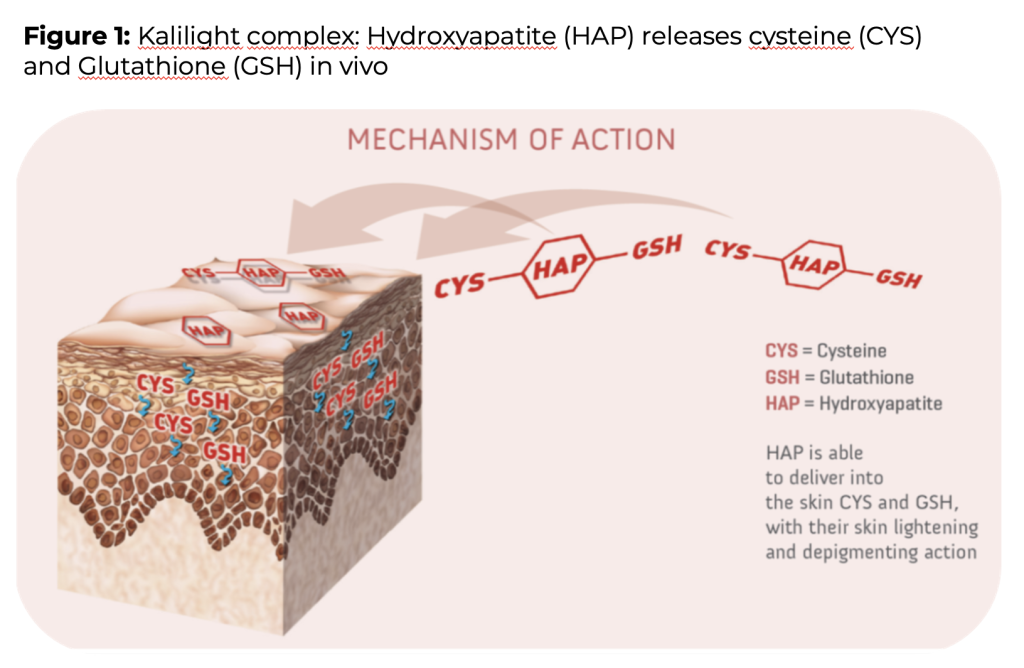
The above-described components of Kalilight perform various anti-pollution activities, summarized below:
- Hydroxyapatite: apart from its known delivery system action, hydroxyapatite is a mineral with a strong adsorbing action on skin lipids, in particular fatty acids and, to a lesser extent, triglycerides. The adsorbent action has a strategic role in the prevention of lipid peroxidation of skin fats exposed to oxidant stress factors (mainly ozone and UV rays) through the adsorption of these fat components, which would otherwise act as a substrate for the formation of ROS, and therefore the formation of free radicals at the epidermal level. Hydroxyapatite also has known anti-bacterial and adsorbent properties on various pathogenic bacterial and viral species, thus representing a potentially strategic component for preserving the balance of the skin microbiota and for contributing to the prevention of colonization of pathogenic species at the stratum corneum level, especially after exposure to pollutants. Last but not least cosmetics treatment with biomimetic HAP highlighted an increase of the skin elasticity and firmness, as well as wrinkle depth reduction.
- Glutathione and Cysteine: Glutathione is a low-molecular-weight thiol-tripeptide, primal to the maintenance of intracellular redox balance: it is an antioxidant present in almost every cell in the body, playing a role in the detoxification of xenobiotics, drugs and pollutants. Furthermore, reduced glutathione acts as a hydrogen donor in the detoxification of hydrogen peroxide. In addition to being one of the richest antioxidants, literature studies have proven its skin lightening properties, following the discovery of its anti-melanogenic properties. It inhibits tyrosinase, scavenges free radicals, and skews melanogenesis from the darker eumelanin to the lighter phaeomelanin, along with excellent tolerance both following oral and topical application. Furthermore, glutathione proved additional features, including anti-wrinkle, skin elasticity both in sun-exposed and sun-protected skin and moisture increase. Cysteine is instead the precursor of glutathione; it is known to be transported across melanosomes through a carrier mediated lysosomal membrane transport system.
Tests and features
Given the lack of generally accepted standards and some methods unreliability and reproducibility in the assessment of the effectiveness of anti-pollution end products, (keeping into consideration that many pollutants are not suitable to in vivo testing upon ethical issues), the current selection criteria of the active ingredient Kalilight is centered around its proven action in promoting skin detoxification, rebalance, and protection, as well as its impact on key parameters and pollution indicators including:
- Modulation of cellular oxidative stress levels (mainly ROS: as previously mentioned, ROS represent the main problem leading to pollution related ageing)
- Skin lipid level (in particular, fatty acids and triglycerides) and clogging of pores (toxins trapped in pores can in fact trigger skin blemishes onset)
- Impairment of skin barrier
- Wrinkles and skin roughness
- Age spots (hyperpigmentation)
ROS reduction
Recently, it has been revealed that reactive oxygen species (ROS) produced excessively in the cells are involved in the process of skin aging caused by UV and pollutants exposure. The stabilized Glutathione functionalized to hydroxyapatite (HAP) mineral network is released on the skin as the result of the interactions established by HAP with the skin slightly acidic pH: the exposure of the biomimetic mineral to the skin determines a steady release of glutathione’s tripeptide.
Glutathione proved significant ROS reduction following the “mitomycin C test”, carried out according to the following protocol: after ROS induction in skin cells through the use of the genotoxic agent mitomycin C, keratinocytes cells are treated with glutathione and placebo to evaluate
the intracellular ROS reduction. ROS levels are measured as oxidation index of a red fluorogenic reagent by mitochondrial superoxide of live cells (that gives a red fluorescence). The results are summarized in Figure 2: glutathione induced a dose dependent reduction of intracellular ROS levels.

Skin lipid level
Hydroxyapatite proved significant benefits in reducing the lipid peroxidation of skin fats exposed to oxidant stress factors (mainly ozone and UV rays) through the adsorption of these fat components; HAP, through its positively charged calcium units establishes chemical links with skin unsaturated fatty acids’ carboxylic groups, leading to their subtraction from skin surface (-43%), hence avoiding their exposure as substrates for the formation of ROS resulting from skin lipid peroxidation
Despite its activity on skin unsaturated fats adsorption, hydroxyapatite does not affect skin sebometry, keeping a balanced equilibrium of the skin hydrolipidic film (analysis carried out through sebumeter SM 815, results are summarized in figure 3) with a consequent lack of comedogenic and pores clogging potential.
Skin barrier integrity and anti-wrinkle
Skin barrier integrity was assessed through analysis made by Cutometer MPA 580, Courage & Khazaka measuring the vertical deformation of the skin surface, when sucked into the opening of a measuring probe. The key values taken under consideration were R2 ( gross elasticity of the skin including viscous deformation, ratio of “ability of recovery” to “final distension” values) and R6 (portion of visco-elasticity on the elastic part of the curve, the smaller the value the higher the elasticity and the skin barrier firmness). In order to evaluate the skin roughness and anti-wrinkle action, skin replicas (SILFLO by Flexico, UK) and a processing software (Quantilines, Monaderm, Monaco) were used. The treatment with biomimetic HAP showed statistically significant skin roughness reduction, skin elasticity and firmness increases (results summarized in figure 3).
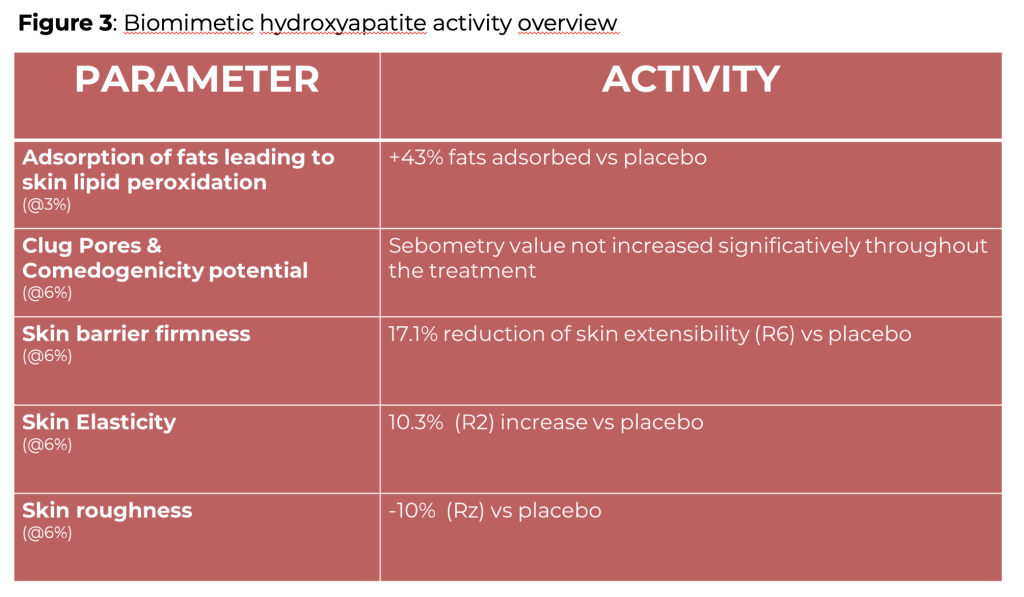
Age Spots
Hyperchromatic skin spots were evaluated with a study carried out on 24 women on a cream containing 3% of Kalilight and a cream containing benchmark actives used at the same dosage (3%), applied twice a day for six weeks; parameters like skin brightness(L*), blue-yellow coloration (b) and individual tipology angle were quantified through ChromaMeter CR400 Minolta, while images were drawn through a UV-scan and Fotofinder dermoscope ver.2.0
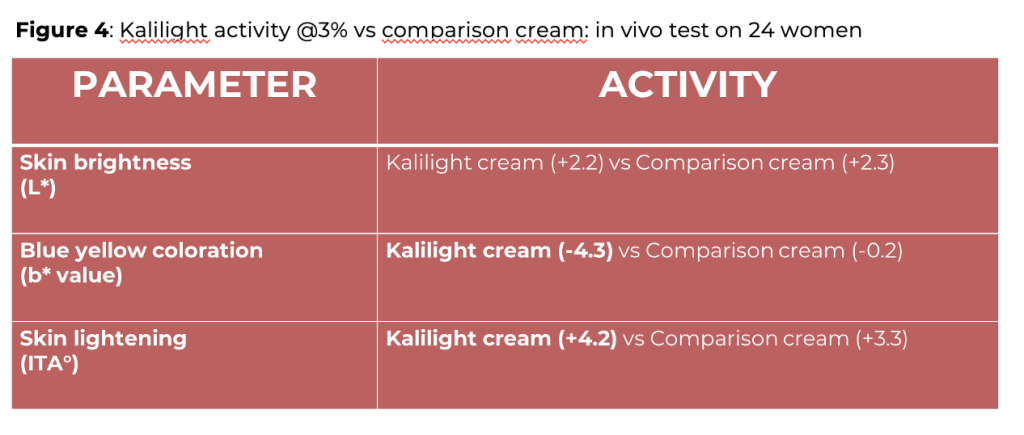
The results summarized in Figure 4 show that Kalilight cream increases skin lightening better than the cream with benchmark actives, while the UV scan and pictures in figure 5 and 6 prove its significant performances in decreasing the intensity of skin spots.
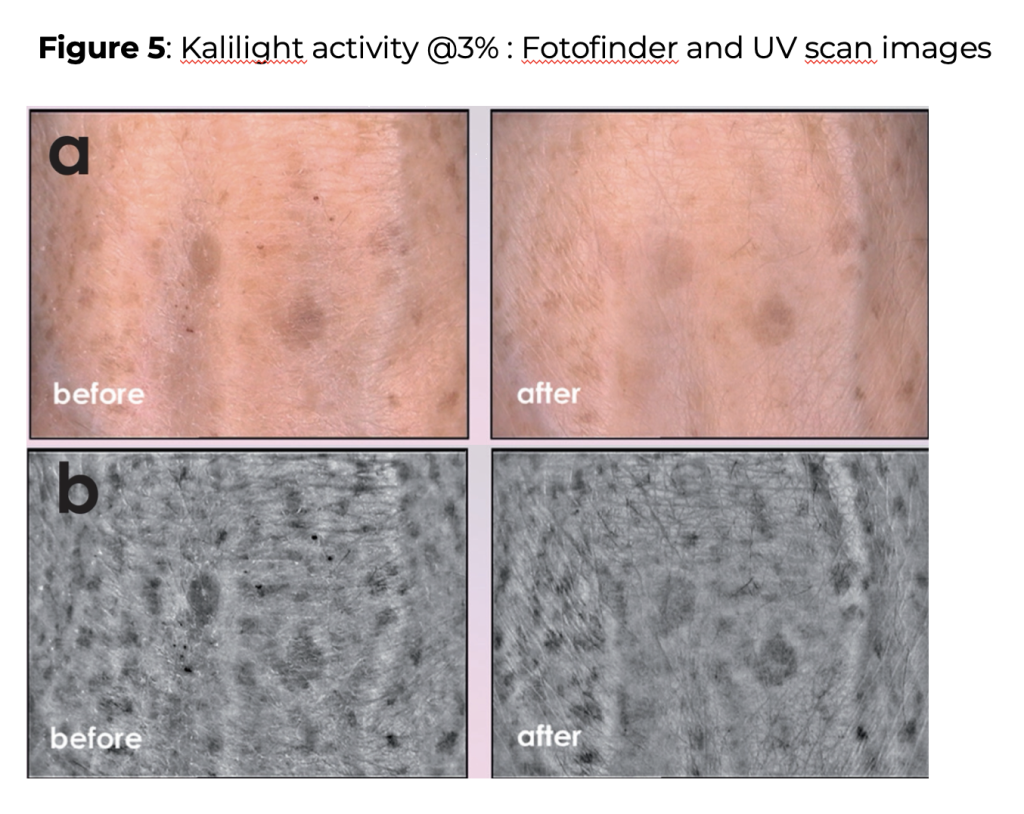


Ingredients
Formulations
Anti-Pollution Serum
Serum containing a patented and innovative anti-pollution biotech specialty (OXISOL) able to protect the skin from pollutants and UV related free radicals.
BB Cream Antipollution & SPF Protection
BB cream containing a cocktail of advanced biotech actives with synergistic anti-pollution, detoxifying and SPF protection.
Purifying & Cleansing Mousse
“Foamy mousse specific for skin purifying. Gentle cleansing, soft after feel.
Ideal for daily use”








